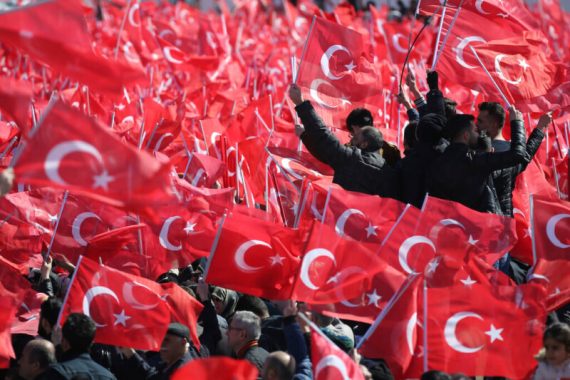M
uch has been written about the winners and losers of Turkey’s May 14 elections, but there is almost unanimous agreement that nationalism was the overall winner. The rise of nationalism in Turkish politics has been continuing unabated for about ten years. Ideologies such as liberalism, socialism, and Islamism, which have an international character, are either localized or weakened. The synthesis of Islamism, conservatism, and nationalism crafted by the AK Party with the foundation of the People’s Alliance has gained social support. Indeed, with this synthesis, the AK Party managed to come first in the parliamentary elections with 35.5% of the vote.
On the other hand, the Nationalist Movement Party (MHP) and the IYI Party each received 10% of votes; more precisely, the MHP 10.07% and the IYI Party 9.69%. The Kurdish ethno-nationalist Green Left Party (YSP) won 8.82% of votes and the Victory Party received more than 2%. If other small parties are included, the total support for the nationalist parties increases even more. Sinan Oğan, the presidential candidate of the ATA Alliance, who defines himself as an “Atatürk nationalist,” played a key role in the presidential race, winning more than 5% of the vote.
As nationalism becomes more popular and all political actors adopt a nationalist stance, it gradually hollows out and the pretexts of nationalism become more prominent. Undoubtedly, a nationalist wave swept the May 14 elections; however, it would be useful to have a closer look at the nature of this wave. Is it a sacred nationalism, a secular nationalism, a statist nationalism, an idealist nationalism, or an anti-immigrant nationalism that has emerged as a reflection of the European far right, a nationalism that focuses on race and ethnicity, an inclusive nationalism that focuses on shared political values, a unionist nationalism, or a Kurdish ethnonationalism?
CHP and HDP getting closer
As a matter of fact, all these types of nationalism could write their own success stories in the May 14 elections. Each claims to be a winner. In particular, the far-right, anti-immigrant line of the Victory Party, which forms the backbone of the ATA Alliance, gained new prominence when Sinan Oğan pushed the elections into a runoff. The political line represented by Muharrem İnce, who was forced out of politics by a FETO criminal cult conspiracy, and his Kemalist approach to politics are being marginalized on the political scene by the Republican People’s Party (CHP) itself. The CHP’s deviation from the Kemalist nationalist position deserves to be addressed as part of a broader political strategy.
Kemal Kılıçdaroğlu, who has politically neutralized the sincere Kemalist line in the CHP since the day he became president, has tried to make his party capable of forming alliances with other ideological positions. Kılıçdaroğlu’s most important “achievement” during his presidency is that he has eradicated the CHP’s Kemalist vein and enabled his party to form alliances with other political actors in order to cross the 25% threshold—historically, the CHP’s maximum support rate. Kılıçdaroğlu’s transformation of the CHP began with bringing his own party’s base closer to the HDP. This was a strategically important move.
In the course of ten years, the HDP and CHP bases have become closer. The rapprochement between the CHP and the HDP was the main strategic thrust that paved the way for Kılıçdaroğlu’s idea of forming the Table of Six. Without the behind-the-scenes CHP-HDP alliance, the other actors would be worthless. It was Kılıçdaroğlu’s CHP that compromised its values. With the purges of Önder Sav, Emine Ülke Tarhan, and, most recently, Muharrem İnce, the Kemalist character of the CHP seems to have been largely destroyed.
The CHP changed its shell
The vacancies left in the CHP by the ousted Kemalists were filled by actors with ethnic, sectarian, or leftist ideologies, and the party changed its shell. The well-known Atatürk nationalist CHP has been replaced by a very different CHP. Although this change caused discontent among the Kemalist faction within the party, many CHP dissidents have either been silenced or cowed into submission in the face of a major rival like Erdoğan. The CHP purged the Atatürk nationalists from its ranks and paved the way for cooperation with “Kurdish ethnonationalists” along the lines of the HDP.
Uniting secular nationalists and Atatürk nationalists in an alliance was the second phase of CHP leader Kılıçdaroğlu’s plan to come to power. It was precisely this gap that the IYI Party tried to fill in Turkish politics: the IYI Party tried to become a rallying point for nationalists who had broken away from the MHP, nationalist Kemalists, and more extreme anti-immigrant populist nationalists. Although the IYI Party gained considerable momentum in the Table of Six format for a while, it lost this upward momentum over time. Kılıçdaroğlu faced IYI Party leader Meral Akşener for his own presidential candidacy and won.
Although Kılıçdaroğlu is adept at neutralizing smaller political actors, he failed to do so in the presidential race. The HDP/PKK shadow over the Nation Alliance was its weakest side. Kılıçdaroğlu, who had to face these criticisms, eventually fell behind President Erdoğan in the first round of the presidential elections. In this environment, Oğan managed to win over the reactionary votes that had broken away from the CHP and İnce.
Recommended
A nationalist approach
In the May 14 elections, Turkish voters preferred a nationalist approach that is closer to a patriotic line expressed in terms of the strength of the state. The political line that received the most support was the nationalist formula that prioritizes a strong state, security, and integrity. Thus, the People’s Alliance, which prioritized the defence industry, an independent foreign policy, and the survival of the state, was the most successful.
This line was agreed upon by the AK Party, the MHP, and the Great Unity Party (BBP). On the other hand, the New Welfare Party (YRP) represented the Islamist-nationalist line, while HUDA PAR manifested a line that synthesized Islamic values with the Kurdish identity. HUDA PAR’s position within the People’s Alliance raised serious questions. As a result, HUDA PAR contributed as much to the People’s Alliance as it damaged it; overall, it could be argued that it contributed to the creation of a more inclusive political framework for the alliance.
The more populist nationalism of the IYI Party has lost momentum due to its participation in Nation Alliance. The Victory Party, which is more associated with the far right and is notable for its anti-immigration stance, has made an interesting entry into Turkish politics. In the coming period, there may be voter transitivity between these two parties.
Under Turkey’s presidential system, as long as the president continues to be elected with a 50%+1 electoral mandate, nationalist parties will continue to be an element of winning alliances. However, the competition between unifying nationalism and divisive and otherizing nationalism will continue to grow in the coming period. The main paradox of nationalist actors in Turkey will be the permeability between these positions. The unifying and state-oriented nationalism of the People’s Alliance was the victor in the May 14 elections; however, as in the West, anti-immigrant and ethnicity-based nationalism is likely to have a place in Turkish politics from now on.
The Victory Party’s recent agreement with Kılıçdaroğlu could backfire by weakening the support of liberal Islamists and Kurdish nationalists who backed Kılıçdaroğlu in the first round of the election.





